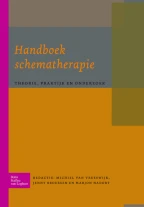25 Validatie van de Schema Mode Inventory (SMI)

De aanwezigheid van schemamodi kan op drie verschillende manieren worden bepaald. Ten eerste door problematische situaties in kaart te brengen waarin patiënten terechtkomen en het gedrag dat zij daarin vertonen te vertalen naar schemamodi. Ten tweede kunnen modi worden getraceerd door experiëntiële technieken te gebruiken waarmee de patiënten terug worden geleid naar het verleden.
This is a preview of subscription content, log in via an institution to check access.
Access this chapter
Subscribe and save
Springer+ Basic
€32.70 /Month
- Get 10 units per month
- Download Article/Chapter or eBook
- 1 Unit = 1 Article or 1 Chapter
- Cancel anytime
Buy Now
eBook EUR 31.47 Price includes VAT (France)
Softcover Book EUR 62.86 Price includes VAT (France)
Tax calculation will be finalised at checkout
Purchases are for personal use only
Similar content being viewed by others

Werken met modi in schemadrama
Chapter © 2015

Een integratief model voor de casusconceptualisatie in Schematherapie
Chapter © 2015

Schematherapie: theorie, praktijk en onderzoek
Chapter © 2017
Literatuur
- Arbuckle, J.L. (2005). Amos 5 for Windows. Chicago: Small Waters. Google Scholar
- Arntz, A., Klokman, J., & Sieswerda, S. (2005). An experimental test of the schema mode model of borderline personality disorder. Journal of Behaviour Therapy and Experimental Psychiatry, 36, 226–239. ArticleGoogle Scholar
- Beck, A., Freeman, A., & Davis, D. (2004). Cognitive Therapy of Personality Disorders (second edition). New York: The Guilford Press. Google Scholar
- First, M.B., Spitzer, R.L., Gibbon, M., Williams, J.B.W. (1996). Structured Clinical Interview for DSM-IV Axis I disorders (SCID-I), Patient Edition (SCID-I/P, Version 2.0). New York: Biometric Research Department. Google Scholar
- First, M.B., Spitzer, R.L., Gibbon, M., Williams, J.B.W., & Benjamin, L. (1997). Structured Clinical Interview for DSM-IV Personality Disorders (SCID-II). Washington, DC: American Psychiatric Press. Google Scholar
- Greenwald, A., McGhee, D., & Schwartz, J. (1998). Measuring individual differences in implicit cognition: the implicit association task. Journal of Personality and Social Psychology, 74, 1464–1480. ArticlePubMedGoogle Scholar
- Jöreskog, K.G., & Sörbom, D. (2001). LISREL 8.54. Chicago: Scientific Software International. Google Scholar
- Klokman, J., Arntz, A., & Sieswerda, S. (2001). The schema mode questionnaire (state and trait version), intern document. Maastricht: Universiteit Maastricht. Google Scholar
- Lobbestael, J., Arntz, A., & Sieswerda, S. (2005). Schema modes and childhood abuse in borderline and antisocial personality disorders. Journal of Behaviour Therapy and Experimental Psychiatry, 36, 240–253. ArticleGoogle Scholar
- Lobbestael, J., Vreeswijk, M.F. van, Arntz, A., & Spinhoven, Ph. (aangeboden voor publicatie). Reliability and validity of the Schema Mode Inventory (SMI). Google Scholar
- Lobbestael, J., Vreeswijk, M.F. van, Arntz, A., Spinhoven, Ph., & ’t Hoen, T. (2005). The Schema Mode Inventory-revised. Maastricht: Universiteit Maastricht. Google Scholar
- Lobbestael, J., Vreeswijk, M.F. van, & Arntz, A. (in voorbereiding). Schema modes in axis I and axis II patients and normal controls. Google Scholar
- Weertman, A., Arntz, A., & Kerkhofs, M.L.M. (2000). Gestructureerd diagnostisch interview voor DSM-IV persoonlijkheidsstoornissen (SCID II). (Oorspronkelijke titel Structural and clinical interview for DSM-IV personality disorders, SCID II). Lisse: Swets Test Publisher. Google Scholar
- Young, J., Arntz, A., Atkinson, T., Lobbestael, J., Weishaar, M., Vreeswijk, M.F. van, & Klokman, J. (2007). Schema Mode Inventory (SMI version 1). New York: Schema Therapy Institute. Google Scholar
- Young, J.E., Atkinson, T., Engels, A.A., & Weishaar, M.E. (2004). The Young Atkinson Mode Inventory. New York: Cognitive Therapy Centre. Google Scholar
- Young, J.E., Klosko, J., & Weishaar, M.E. (2003). Schema therapy: A practitioner’s guide. New York: The Guilford Press. Google Scholar
- J. Lobbestael

